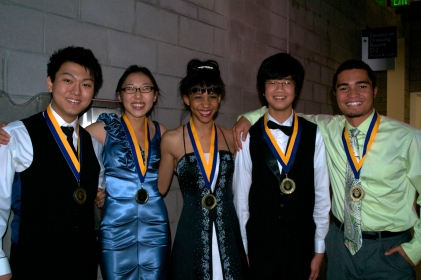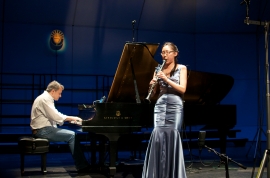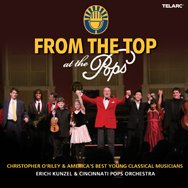 From the Top’s broadcast for Show 270 was taped at the University of Georgia’s Hugh Hodgson School of Music in Athens, GA on Sunday March 3, 2013. We asked our performers to tell us more about their experience on the show…
From the Top’s broadcast for Show 270 was taped at the University of Georgia’s Hugh Hodgson School of Music in Athens, GA on Sunday March 3, 2013. We asked our performers to tell us more about their experience on the show…
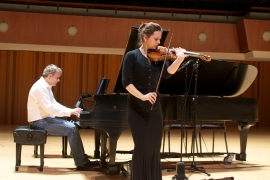 Maria Ioudenitch, 17, violin
Maria Ioudenitch, 17, violin
Scherzo-Tarantelle, Op.16
By: Henryk Wieniawski
The Scherzo-Tarantella merges precision, tenderness, and passio to create a masterpiece of virtuosity. I have neither a favorite nor least favorite part, as all aspects contribute to an incredible entity, which has no boundaries of emotion. This piece begins with grandeur, and technique, flows into a graceful middle section, and continues to bring the brief “Cantabile” of lighthearted yet passionate excitement. Finally, the Scherzo-Tarantella ends back at “Tempo I”, reiterating the brightness of the beginning.
This piece is special in it integration of various points of the emotional spectrum. Unlike some other pieces in my repertoire, the Scherzo-Tarantella brings out my still (thankfully) youthful energy to the maximum, with no need to suppress it. This piece highlights the difficulty of control, in regard to technique. However, by working on this control, I gain ability to structure the masterpiece and hopefully pass on to the audience the great love that it brings out in me.
Post-Show Reflection: my favorite moments were being backstage with my fellow performers, and then walking out onto the stage and looking at the warm, accepting audience. Of course, the performance itself was the best experience. I was shaking, my hands were cold, my heart was beating irregularly…the nervous aspect coalesced with the excited. When I started to play, my mind was in technique, but after about 12 seconds my heart overcame and joined the music.
Music has the power to affect others.
 Wickliffe Simmons, 19, cello
Wickliffe Simmons, 19, cello
“Kaddish”
By: Maurice Ravel
Well there is a story behind this piece. In January, a good friend and I put together a memorial benefit concert at our school for the victims and families of the Sandy Hook Elementary School tragedy, Each piece was put in the program for a specific reason. We chose this piece because in Judaism, a Kaddish is the prayer for the dead. The idea we had in mind was that some things are beyond verbal description, so through music we could reflect and reach out to the Sandy Hook families, and faith or no faith, we wanted this piece to honor the students and teachers who were lost that day.
It has a very vocal or cantor-like quality. When I play it, I feel like I am solemnly pacing through a morphing, impressionistic atmosphere. This piece was written originally for voice and piano. Since the cello, in my opinion, is the closest string instrument to the human voice, it’s pretty cool that you can sing this piece without words. My teacher says that I should imagine that I am a Jewish cantor singing this prayer. I guess the hard part about playing this piece is making it have the same natural rise and fall of the human voice – just making it sound authentic and knowing the pacing you want to take before playing it.
Post-Show Reflection: It was great t meet all of these new, amazingly talented people, and realize how we all seem to know a lot of the same people. The rehearsals got rid of a lot of my anxiety before the show. When I walked onto the stage, the thought wasn’t to panic, but instead to just let go.
Music can speak as a language of its own, and draws out an emotional response.
 Bokyung Byun, 18, guitar
Bokyung Byun, 18, guitar
“Recuerdos de la Alhambra” (Memories of the Alhambra)
By: Francisco Tárrega
The last two chords of the piece always confuse people. They often start clapping when the first chord is played because they think it is the end of the piece. In fact, the last chord often doesn’t get the chance to be heard. A friend of mine suggested that if audiences start clapping after the first chord, instead of bowing, I should wait until people stop clapping and play the last chord.
When I play this piece, I imagine a guitarist accompanying a singer singing the melody. I found it challenging to make the melody sing on the guitar, while making the accompaniment interesting at the same time. When I tried to listen to the melody, the accompaniment became too boring. When I tried to make the accompaniment interesting, the melody was not singing anymore.
Post-Show Reflection: My favorite memory was the pizza party! I loved how the staff members were so nice and supportive of us all the time. Also, it was nice to meet everyone for the first time. The performance itself was very relaxing. The audience was amazingly cheerful, and I really enjoyed performing for them.
I believe that music has the power to describe things that words cannot.
 Ariela Bohrod, 17, piano
Ariela Bohrod, 17, piano
Andante Spianato and Grande Polonaise Brillante, Op.22
by Frédéric Chopin
Post-Show Reflection: I loved taking the quiz for my on-air interview! I learned some hilarious new things about the food preferences of famous pianists, and even though I only answered one of the three questions correctly, it still was a hoot. For the show, I thought I would be anxious to perform, but I was having too much fun to feel nervous.
Music is a universal language – something everyone can understand. It’s something that can connect people, help us to put aside our differences, and come together. I believe music has the power to change the world.
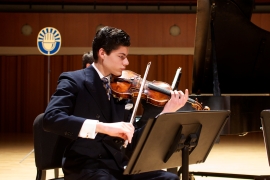 Hartman-Warren-Doyle Trio
Hartman-Warren-Doyle Trio
I. Moderato Assai from Piano Trio in G minor, Op.15
By: Bedřich Smetana
Luther Warren, 17, violin
In me, this music awakes images of the vase, rolling Czech countryside. Although I’ve never visited the Czech Republic, these images are vivid and tangible. This piece was written immediately following the death of Smetana’s daughter. As a result it conveys and enormous amount of grief, suffering, and poignancy. This is the mist important aspect to communicate to the audience.
Post-Show Reflection: My favorite memory was sitting in the Green Room with the rest of my trio while the show was starting. Only when we heard the crowd begin to cheer that what we were about to do really sank in for me. Performing on the stage at the show was about what I would imagine being in a 1950s live-broadcast TV show would be like. There was a rush of inherent and exciting energy about it all.
Music has the potential to bring beauty to a person’s life on a level far deeper than most other things can reach.
 Nora Morrissey Doyle, 16, cello
Nora Morrissey Doyle, 16, cello
This piece is one that is filled with grief. Our coach told us about how Smetana wrote this trio after his daughter died from an illness, and I think that you can hear those emotions of grief throughout the piece. It speaks to his sorrow and frustration, but there are also fond memories, like when you hear the beautiful cello melody. My favorite part of the piece is in the beginning, when the cello joins the violin as the violin repeats its descending line and the cello plays an ascending one.
There are some places with tricky rhythms, and we had to work hard to get those places together. But those rhythms also add to the tension and the emotion of the piece. As with any ensemble, the blending of the different voices for just the right combination is a challenge. In this piece the dominant instrument changes around at times, and so we must listen carefully.
Post-Show Reflection: My favorite memory was meeting all of the performers and production staff at the pizza party. For the show, I was more comfortable than I’d expected. Having done the dress rehearsal in the morning, playing on that stage wasn’t as scare anymore. In fact, the only thing different from the dress rehearsal, to the performance was having a live audience, which was totally energizing.
Music can do basically anything, I think. It can transcend time, culture, distance, and bring people together. It allows people who don’t even necessarily speak the same language to communicate fluently.
 Derek Hartman, 15, piano
Derek Hartman, 15, piano
This piece explores many different emotions, all of which transition between each other in a matter of seconds. My favorite part is the long violin solo, where Luther hits a high B flat. My least favorite part is the section where the strings are playing triplets while I play loud, C major chords, which lasts for several measures. I fell like the storyline follows different paths of pain and sorrow, as many emotions run through us at once when we experience that.
This piece has a strange piano part. Unlike most romantic piano trios, the pianist doesn’t have too many virtuosic parts; however, the part is surprisingly difficult. The chordal and octave passages make it a tough piece. The hardest thing to nail is the right amount of “portato”.
Post-Show Reflection: In addition to performing (obviously), I enjoyed going out for dinner with all the “talent.” It was fun to get to know everyone. I didn’t think the performance was stressful at all – it was one of the most lighthearted, fun experiences I have ever had in a performance; very inspiring and invigorating.
Music has the power to bring people together for a common cause. It is also entertaining and provides a purpose, something to work for – it inspires, and provides hope.
Filed under: Uncategorized | Tagged: listening, radio | Leave a comment »
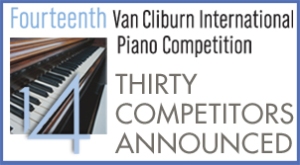 The Van Cliburn Competition was founded in 1962 to recognize the great pianist Van Cliburn, who passed away in February 2013. In its 50-year history, the Cliburn has identified and ushered a host of exceptional artists to international prominence, including From the Top host Christopher O’Riley.
The Van Cliburn Competition was founded in 1962 to recognize the great pianist Van Cliburn, who passed away in February 2013. In its 50-year history, the Cliburn has identified and ushered a host of exceptional artists to international prominence, including From the Top host Christopher O’Riley.













